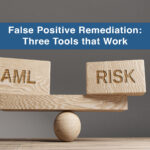Commercial real estate: Likely types of money laundering and sanctions evasion
FinCEN in a recent alert warned financial institutions to look for BSA AML Compliance violations in commercial real estate (CRE) transactions. The alert, reprinted in part here, focused especially on possible evasions by sanctioned Russian oligarchs and their proxies.
FinCEN, the U.S. Financial Crimes Enforcement Network, has identified methods of potential sanctions evasion in the CRE market. FinCEN emphasizes that these typologies and the red flag indicators represent only a sampling of possible sanctions evasion or other illicit activity.
The use of pooled investment vehicles in CRE
CRE investors seeking to evade sanctions may use pooled investment vehicles, including offshore funds, in order to avoid KYC CDD and beneficial-ownership protocols established by financial institutions. These tactics can help them evade detection.
In many cases, owing to the number of investors involved in a fund, an individual investor will own less than 25 percent of the fund. This level of ownership interest will therefore fall below the threshold for beneficial-ownership screening by banks that work with funds in CRE financing.
Some banks lower their due-diligence threshold to 10 percent ownership for high-risk customers. But investors seeking to evade sanctions may lower their interest in a fund to just below that threshold to avoid the bank’s detection.
These investors may in fact be general partners that have actual control of the fund, but their ownership interest will fall beneath a bank’s adjusted CDD ownership threshold meant to identify bad actors.
The role of shell companies and trusts
Bad actors may use shell companies and trusts to conceal their ownership stake in a CRE property. Locations for these shell companies and trusts include the United States and other jurisdictions.
Financing and ownership of high-value CRE properties often include many layers of legal entities and trusts, according to FinCEN. And complex deals involve ownership and financial institutions spread across multiple jurisdictions around the world. These features can make it difficult for BSA-regulated financial institutions to identify the beneficial owners of these entities.
Furthermore, legitimate businesses (e.g., real estate development or asset management companies) will also frequently, even if unwittingly, be part of CRE ownership structures involved in a sanctions-evasion scheme. This creates an additional challenge for financial institutions in identifying the bad actors.
The involvement of third parties
The use of third parties to invest in CRE on behalf of a corrupt actor remains a common tactic for laundering money and engaging in other illicit finance schemes. Sanctioned Russian elites and their proxies, for example, may use relatives, friends, or business associates to set up the legal entities to invest in CRE projects. They also may create trusts through which to invest in the properties and to hold the assets.
When analyzing trusts for which a sanctioned person was at any time the grantor/settlor, trust protector, trustee, or beneficiary, financial institutions should take particular care to ensure that sanctioned persons do not have a present, future, or contingent property interest in the trust.
Inconspicuous CRE investments that provide stable returns
Bad actors also may seek to avoid detection by investing in CRE projects that are less likely to be noticed by the general public or otherwise draw unwanted attention. These CRE projects can vary tremendously in kind, but they need not be high-end or luxury properties. They could include CRE in the multifamily housing, retail, office, industrial, or hotel sectors. In many cases, sanctions evaders may seek out inconspicuous investments so long as they provide stable returns.
Furthermore, there are no central geographic hubs where sanctioned Russian elites and their proxies in particular may be focusing their U.S. CRE investments. As a result, it is just as likely that attempted sanctions evasion is occurring in the CRE markets in small- to mid-size urban centers and throughout the United States as it is to take place in the largest cities.
The role of financial institutions in CRE transactions
Various types of financial institutions with regulatory obligations under the BSA are involved in CRE transactions. These institutions should apply a risk-based approach to identifying and reporting potential sanctions evasion any bad actor, including by sanctioned Russian elites and their proxies.
For example, banks frequently work with market participants that are seeking financing for CRE projects. These market participants include developers, private investment vehicles, and various other types of companies.
Banks are also one of the BSA-regulated financial institutions with KYC CDD obligations, requiring them to verify the beneficial owners of legal-entity customers. Banks therefore may be in a position to identify and report suspicious activities associated with sanctioned Russian elites and their proxies including PEPs, among banks’ CRE-related customers.
Insurance companies are another type of financial institution with obligations under the BSA, and they play a significant role in CRE financing. At year-end 2021, insurers held $556.7 billion in CRE debt. Insurance companies may in some cases be in a position to determine whether their CRE- related activities have exposure to bad actors that include sanctioned Russian elites and their proxies.
Furthermore, the CRE market frequently involves loan syndication, which may include banks, life insurers, and other types of BSA-regulated financial institutions.
Section 314(b) of the USA PATRIOT Act provides financial institutions with the ability to share information with one another on suspected money laundering or terrorist activities under a safe harbor that offers protections from liability.
FinCEN strongly encourages this information sharing to occur with respect to potential CRE-related sanctions evasion by bad actors, including sanctioned Russian elites and their proxies, including during the process in which loans are developed and structured.
______________

GRC Compliance platform provides end-to-end solutions
With AML Partners’ platform technology for RegTech, updating and upgrading your AML and eGRC software solutions is easier, faster, and much less expensive. Contact us today to explore how platform technology and our end-to-end AML Ecosystem powered by the RegTechONE platform–can transform the efficiency and effectiveness of your unique AML Compliance efforts. RegTechONE software for AML Compliance includes fully integrated modules for CDD KYC software for on-boarding, behavior and transaction monitoring software, and sanctions screening software for comprehensive AML screening. And AML Partners simplifies your end-to-end fully integrated AML Compliance efforts even further with an optional Subpoena Search module for FinCEN 314a and similar subpoena searches. Contact us today to learn about our proof-of-concept option or schedule a demo of RegTechONE, the AML software ecosystem. With extraordinary configurability and built for API extensibility, the RegTechONE AML software platformpowers not only an end-to-end AML software solution but also vendor management, AML client lifecycle management, eKYC Golden Records, Perpetual KYC, and so much more.

